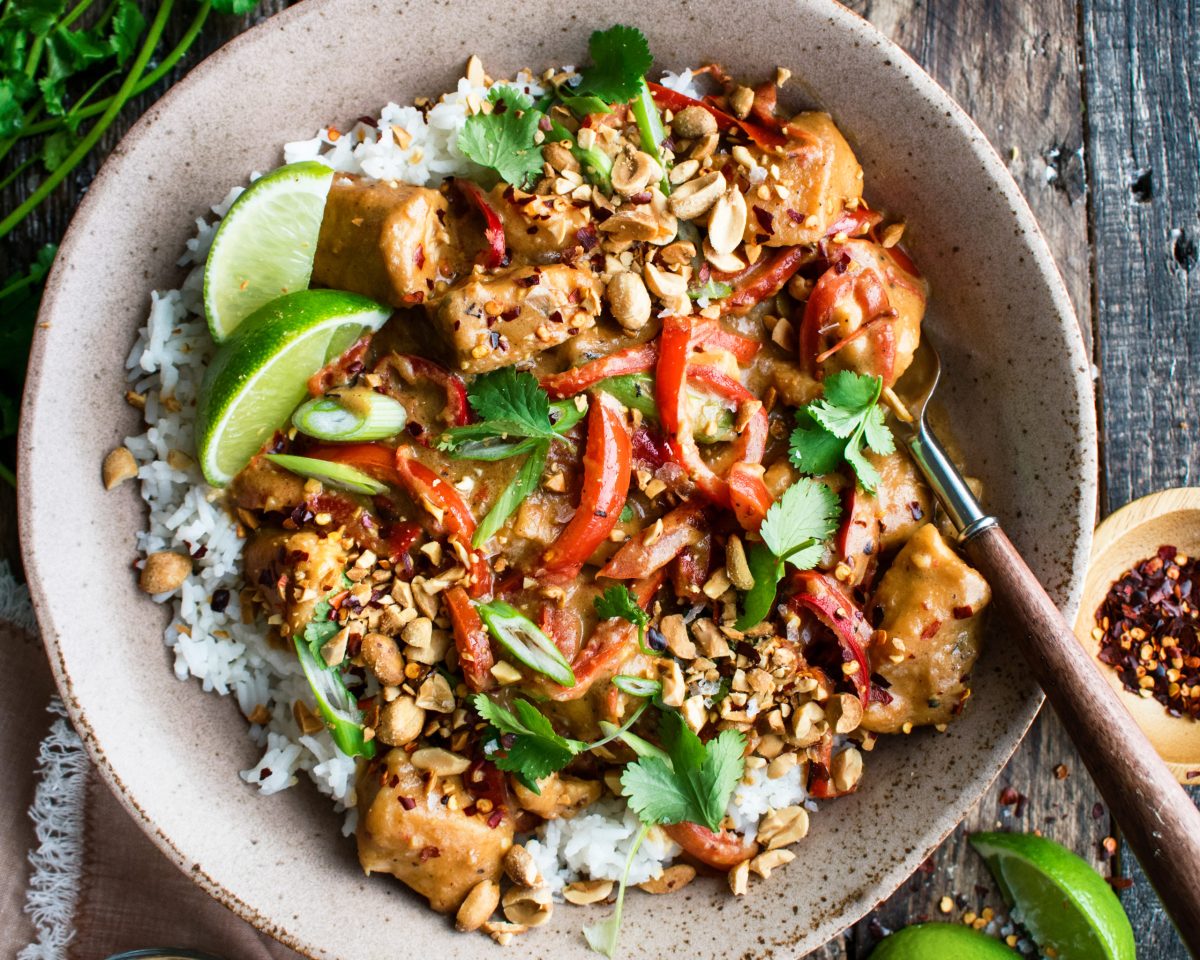Embark on a culinary adventure into the vibrant world of Thai cuisine, reimagined for the paleo lifestyle. This guide unveils the secrets to crafting authentic, fiery Thai curries – red, green, and yellow – entirely from scratch, using only paleo-friendly ingredients. Discover the art of creating flavorful curry pastes, selecting the perfect protein and vegetable pairings, and mastering the techniques to achieve that perfect balance of spice and savor. Prepare to tantalize your taste buds and nourish your body with these delicious, healthy, and surprisingly easy-to-make curries.
From understanding the nuances of traditional Thai curry paste preparation to modern shortcuts, this comprehensive guide provides detailed, step-by-step recipes, stunning visuals, and expert tips. Learn how to choose the freshest, highest-quality ingredients to unlock the full potential of each curry, and explore a range of serving suggestions and variations to personalize your culinary creations. Get ready to elevate your home cooking to a whole new level of flavor and satisfaction.
Authentic Thai Paleo Curry Pastes
Creating authentic Thai curry pastes at home allows for complete control over ingredients and spice levels, resulting in vibrant, flavorful curries that adhere to paleo principles. This section details three fundamental paleo-friendly Thai curry pastes – red, green, and yellow – outlining their unique ingredient profiles, preparation methods, and nutritional benefits.
Paleo-Friendly Thai Curry Paste Recipes
The following recipes provide a foundation for creating delicious and healthy paleo-friendly Thai curry pastes. Remember that adjustments to spice levels are easily achieved by modifying the quantity of chilies. The vibrant colors and aromas of these pastes are indicative of their rich flavor profiles.
| Name | Ingredients | Spice Level | Flavor Profile |
|---|---|---|---|
| Red Curry Paste | Dried red chilies (soaked), lemongrass (finely chopped), galangal (finely chopped), shallots (finely chopped), garlic (finely chopped), shrimp paste (optional, substitute with nutritional yeast for a vegan option), kaffir lime leaves (finely chopped), turmeric (powdered), coriander (powdered), cumin (powdered), salt. | High | Rich, savory, slightly sweet, with a strong chili heat. |
| Green Curry Paste | Green chilies (stems removed), cilantro stems (roughly chopped), lemongrass (finely chopped), galangal (finely chopped), shallots (finely chopped), garlic (finely chopped), kaffir lime leaves (finely chopped), makrut lime zest, green peppercorns (crushed), cumin (powdered), coriander (powdered), salt. | Medium-High | Bright, herbaceous, slightly sweet, with a vibrant chili heat. |
| Yellow Curry Paste | Turmeric (fresh, grated or powdered), lemongrass (finely chopped), galangal (finely chopped), shallots (finely chopped), garlic (finely chopped), coriander (powdered), cumin (powdered), black peppercorns (crushed), salt. | Mild | Earthy, warm, slightly sweet, with a subtle hint of spice. |
Traditional vs. Modern Curry Paste Preparation
Traditional Thai curry paste preparation is a labor-intensive process, often involving pounding ingredients in a mortar and pestle until a smooth paste is formed. This method releases the essential oils and creates a complex flavor profile. Imagine the rhythmic thud of the pestle against the mortar, the fragrant steam rising as the ingredients are crushed and combined, a testament to the artistry and time-honored techniques.
Modern methods utilize food processors or high-powered blenders for a quicker and more convenient approach. While this simplifies the process, some believe it compromises the texture and depth of flavor achieved through traditional pounding. The vibrant hues of the paste, whether achieved through traditional pounding or modern blending, speak to the freshness and quality of the ingredients.
Nutritional Benefits of Paleo Curry Paste Ingredients
The ingredients in these paleo-friendly curry pastes offer a wealth of nutritional benefits. The abundance of fresh herbs and spices provides potent antioxidants, while the shallots and garlic contribute to immune support. The vibrant colors of the chilies, turmeric, and other spices are a visual representation of their powerful health-boosting properties. Turmeric, for example, is renowned for its anti-inflammatory properties, while ginger offers digestive support. Lemongrass provides a refreshing citrusy note and also boasts antimicrobial properties. The overall combination creates a nutrient-dense foundation for a flavorful and healthy meal.
Choosing the Right Protein & Vegetables

Selecting the perfect protein and vegetables is crucial for creating a vibrant and flavorful paleo Thai curry. The right combination not only enhances the taste but also contributes to the nutritional profile of your dish, offering a balanced and satisfying meal. The choice of protein should complement the intensity of the curry paste, while the vegetables should offer a textural and flavor counterpoint. Consider seasonal availability for the freshest and most delicious results.
The richness and depth of flavor in a Thai curry are greatly influenced by the quality of the ingredients. Opting for organic, locally sourced produce whenever possible ensures superior taste and nutritional value. The freshness of your ingredients will directly impact the final outcome, making the difference between a merely good curry and an exceptional one. High-quality protein, such as free-range chicken or sustainably sourced fish, will also contribute significantly to the overall experience.
Paleo-Friendly Protein Sources and Cooking Methods
Several excellent paleo-friendly protein sources pair beautifully with Thai curries. The cooking method should be chosen to complement both the protein and the specific curry paste, ensuring optimal texture and flavor.
- Chicken: Chicken thighs, with their higher fat content, are ideal for red and yellow curries, where they can render delicious fat into the sauce. Pan-frying or roasting until golden brown and cooked through ensures a tender and flavorful result. Chicken breast, while leaner, works well in green curries, where the sauce is lighter and less rich.
- Fish: Firm, white fish like cod or snapper are excellent choices for green and yellow curries. Their delicate flavor won’t overpower the paste, and they cook quickly to prevent over-drying. Gentle steaming or pan-searing are ideal methods.
- Beef: Lean cuts of beef, such as sirloin or flank steak, are best suited for red curries. Their robust flavor holds up well against the intense spices. Slow cooking or stir-frying, allowing for a tender texture, is recommended.
- Pork: Pork shoulder or belly, with its higher fat content, is perfect for red curries, adding richness and depth to the sauce. Slow cooking, braising, or roasting are ideal methods to achieve tender, flavorful results.
- Shrimp: Shrimp cooks quickly and absorbs the flavors of the curry paste beautifully. It is an excellent choice for all three types of curries, especially green and yellow, where its delicate flavor is best showcased. Stir-frying or adding it towards the end of cooking ensures it remains succulent and tender.
Vegetable Pairings for Different Curry Pastes
The selection of vegetables plays a significant role in balancing the flavors and textures of your Thai curry. Seasonal availability ensures peak flavor and freshness. The following chart highlights ideal vegetable pairings for each curry paste type.
| Curry Paste | Seasonal Vegetables (Examples) | Flavor Profile |
|---|---|---|
| Red |
|
Rich, earthy, slightly sweet |
| Green |
|
Bright, herbaceous, slightly spicy |
| Yellow |
|
Mildly sweet, subtly savory |
Mastering the art of Spicy Thai Paleo Curries opens a world of flavor and culinary creativity. This journey, from crafting authentic curry pastes to perfecting the final presentation, empowers you to create restaurant-quality meals in the comfort of your own kitchen. With a deeper understanding of ingredient selection, flavor balancing, and presentation techniques, you’ll confidently experiment with variations and personalize each curry to suit your taste. So, gather your ingredients, embrace the vibrant spices, and embark on a delicious adventure in paleo Thai cooking!
FAQs
Can I substitute coconut milk with another dairy-free option?
While coconut milk provides the best traditional Thai flavor and texture, you can experiment with full-fat coconut cream for a richer consistency or cashew cream for a slightly nuttier taste. However, the flavor profile might be subtly altered.
How long can I store leftover curry?
Store leftover curry in an airtight container in the refrigerator for up to 3-4 days. The flavors will often deepen over time.
What if I don’t have all the specific ingredients listed?
Feel free to adapt the recipes to what you have available. While the specific ingredients contribute to the authentic Thai flavor, substitutions can be made based on your preferences and availability, keeping in mind the overall flavor profile.
Can I adjust the spice level for milder palates?
Absolutely! Reduce the amount of chili peppers in the paste or add less paste to the curry itself. You can also add a touch of sweetness with a small amount of coconut sugar or honey to balance the heat.


